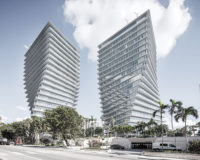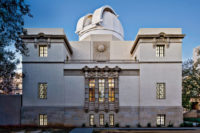The Beach at Expedia Group by Surfacedesign
Seattle

Architects & Firms
James Lord and Roderick Wyllie, partners at the San Francisco–based landscape firm Surfacedesign, acknowledge that new tech parks can often feel anonymous. To prevent this effect, especially when working with corporate clients, they always seek to strike the balance between flexibility and character in their landscapes. “We’re not asking people to come and be nowhere—we’re asking people to come and be where they are,” explains Wyllie. The “where,” in this case, is the 2.6-acre “Beach” at Expedia Group’s new campus on the shores of Seattle’s Puget Sound. Formerly belonging to a biotech company, the entire 40-acre site became the travel giant’s headquarters last fall.
The Beach, a privately owned park that is open to the public, is part of a larger campus that includes a new building by ZGF and a small pavilion by Aidlin Darling, all tied together by an overall landscaping scheme. This waterfront area, which is a patchwork of tall grasses and, in addition, layers pebbles and driftwood throughout the site, also overlaps with a portion of the Elliott Bay Trail, a popular running and biking path for locals. Here, Surfacedesign separated the existing bike and pedestrian paths and rounded a 90-degree turn into a gentle arc for added safety.

Native wetland species and repurposed driftwood were used throughout the park. The logs, which serve as benches, face views of Mt. Rainier in the distance. Photo © Marion Brenner, click to enlarge.
“We talked about how to pull people out from their desks into the landscape,” says Lord, pointing to the increased productivity that comes from spending time in nature. “The big move,” as he calls it, was extending the urban waterfront edge deeper into the site, “to the front door of Expedia’s campus,” by taming the previously inaccessible shoreline with pathways, plantings, and seating.
Before this slice of land was home to corporate entities, it was a more rugged kind of workplace. Its previous life included a series of commercial finger piers that served as a crossroads for the shipping, railroad, and logging industries that have defined the Pacific Northwest for generations.
Slowly, over the years, the site was filled in, leaving Surfacedesign to conduct extensive soil remediation. “The success of any landscape is what happens underground,” explains Lord. As part of its site analysis, the team worked with soil scientists to concoct bespoke “compost teas” of helpful bacteria and fungi, among other microbes, to inoculate the land for optimal planting conditions—all part of a chemical-free bioretention strategy considered “salmon-safe.”

Elevated concrete “terraces” create a wind barrier and seating areas. Photo © Marion Brenner
To manage stormwater runoff, Surfacedesign subtly graded the entire site. Where the park comes to a point, on the footprint of a former pier, an elevated series of curved concrete “terraces,” padded with grass between levels, descends toward the water, designed to provide a graceful wind barrier to those in the lookout area. Amid these elevated forms live a variety of mostly native wetland plantings, including tufted hairgrass and meadow barley, that naturally treat runoff before it flows into the sound. These meadows were designed as alternatives to seawalls, able to defend against rising seas. Here, wild patches of grassy flora sway in the coastal breeze, resilient in the face of the Pacific Northwest’s unpredictable elements. Repurposed driftwood logs from a neighboring port are used as seating around the Beach, strategically placed to maximize views of the Seattle skyline and Mt. Rainier in the distance.
Though intended for outdoor meetings, the Beach has been hosting small musical performances, yoga, and other open-air activities, even during recent months seized by COVID-19. “Especially in these times, it has been a huge relief,” says Lord of the park. “There’s nothing more exciting than that Titanic-esque moment of being out on the point looking back at the city, the Sound, the Olympic Mountains, and realizing where you are in the world and how special Seattle is.
Click plan to enlarge








